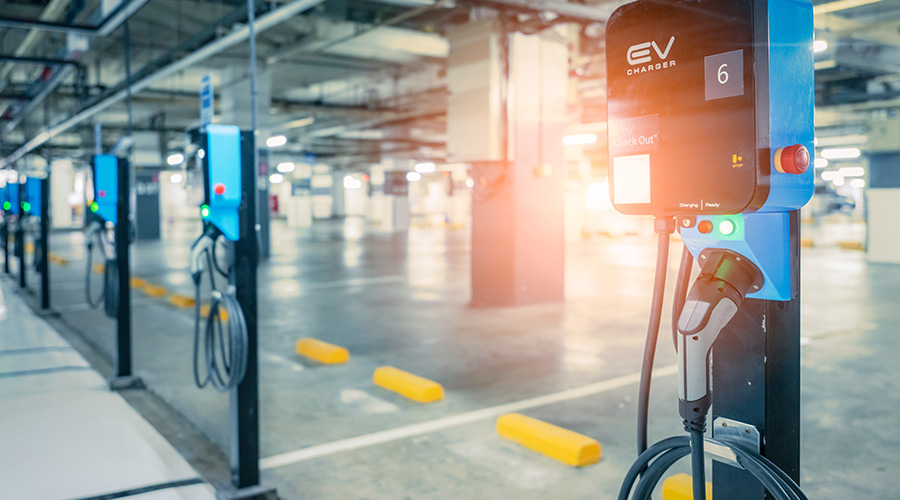The Case for Accessible Electric Vehicle Charging Stations
Here are some important tips and strategies for how to design EV Charging Stations with accessibility in mind.
By Ashley Pitts, Contributing Writer
Electric vehicle charging stations (EVCS) are becoming increasingly necessary as electric vehicles become more widely adopted. Many jurisdictions across the United States now require certain facilities to incorporate EVCS when requesting permits for new construction, additions or alterations. More and more, facility operators are installing EVCS based on demands from tenants and building occupants and to meet their own sustainability goals.
All features and amenities provided at a facility must be accessible and usable by people with disabilities, and this holds true for EVCS. For newly constructed facilities, accessible EVCS must be in full compliance with codes, while EVCS installed as an alteration to an existing facility must comply to the maximum extent feasible.
Until recently, there was confusion on how best to provide accessible EVCS. Fortunately, several resources have been developed over the last few years, offering guidance for operators and architectural and engineering teams incorporating EVCS into facility plans.
Applicable codes and standards for EVCS accessibility
An electric vehicle charging station is a vehicle space served by an electric vehicle charging system. The 2021 edition of the International Building Code (IBC) includes language requiring that a certain percentage of vehicle spaces serving electric vehicle charging systems be accessible. However, accessible EVCS should not be counted toward the code-required minimum number of accessible parking spaces. The two functions are treated separately to ensure access is provided to each function.
Additionally, the 2021 IBC provides dimensional criteria for the required accessible vehicle spaces and their adjacent access aisles. It also references the 2017 edition of ICC A117.1, Accessible and Usable Buildings and Facilities, which includes technical criteria for the operable parts of the charging equipment, accessible routes to the charging equipment and prohibited obstructions.
It is recommended to always check the local and state codes enforced in your facility’s jurisdiction. Some jurisdictions may modify these requirements or issue their own requirements for accessible EVCS. An example is the California Building Code, which for several years has contained scoping and technical criteria specific to accessible EVCS.
A second place to look for guidance is the U.S. Access Board’s technical assistance document, Design Recommendations for Accessible Electric Vehicle Charging Stations. While federal accessibility standards do not yet contain criteria specific to EVCS, it is clear that the Americans with Disabilities Act of 1990 (ADA) and other federal laws governing accessibility in buildings and facilities require access to such a feature or amenity as a matter of civil rights. The U.S. Access Board’s technical assistance document provides us with design considerations to comply with the ADA and other federal laws.
Considerations for designing accessible EVCS
According to the U.S. Access Board’s technical assistance document, a reasonable number of accessible EVCS must be provided based on the number of each type of EVCS provided in the facility. It also discusses the accessible vehicle space, access aisle, accessible route, clear floor or ground space and operable parts at the charging equipment, and signage.
Size. Because electric vehicles do not all have the same charging inlet location, flexibility should be built into the design layout for vehicle spaces serving accessible EVCS. A wider vehicle space and access aisle provides enough space for a person using a mobility device to enter, exit and maneuver around their vehicle while also being able to travel to and from the charging equipment. A 132-inch-wide vehicle space and 60-inch-wide access aisle are required by 2021 IBC Section 1107.2.2 and recommended by the U.S. Access Board. Providing a longer-than-usual vehicle space is also preferred.
Placement. The charging equipment must be on an accessible route and have a level, clear floor or ground space serving all operable parts. The accessible vehicle space and access aisle should comply with the same ground surface criteria applied to designated accessible parking spaces, such as not exceeding 1:48 maximum slope in any direction.
Elements like bollards, curbs, and wheel stops can be used to protect equipment from damage and prevent parked vehicles from encroaching on the accessible route and the equipment clear floor or ground space. It is crucial, however, that these elements do not obstruct access.
Ideally, the charging equipment should be on the same level as the vehicle space and access aisle, which may require modifying typical designs for curbs and landscape islands. The equipment placement must be such that the charging cable will not obstruct the accessible route when deployed or stored.
Usability. Operable parts of the charging equipment must be within accessible reach range and meet usability criteria. Communication aspects of the charging equipment must be considered to ensure that the devices are usable by an expanded user group, including people who are deaf or hard of hearing or have low vision. The U.S. Access Board recommends that all chargers provided in a facility have accessible communication features.
Signage. Accessible parking spaces have specific signage requirements and must be identified as reserved for people with a disability placard or license plate. At this time, federal accessibility standards, IBC and ICC A117.1 do not contain signage criteria for accessible EVCS, though some local or state codes do.
Again, always check the local codes applicable to your facility. Absent design criteria for EVCS signage, facilities would not be required to reserve accessible EVCS for people with a disability placard or license plate. Moreover, it may not be desirable to do so when only a few EVCS are provided at a facility. Posting “Use Last” signs at accessible EVCS may keep them open longer while still allowing people without disability placards to use them when needed.
Route. Also, consider the connection between accessible EVCS and the accessible facility entrances. Achieving a safe, accessible route may mean installing pathways that include curb ramps and raised crosswalks to better protect pedestrians moving through a vehicular area. Typically, coordination between the architect, civil engineer and landscape architect is needed to ensure accessible EVCS while maintaining pedestrian circulation, site drainage and landscape design goals.
Whether constructing a new building or making improvements to your facility, making EVCS accessible and usable for people with disabilities is essential. Given the expense of installation, designing accessible EVCS from the outset can help avoid potential complaints or costly retrofits later. Consult with your architectural and engineering team to determine the appropriate design layouts for accessible EVCS and the connecting accessible routes at your facility.
Ashley Pitts, AIA, APAC-BE, CASp, is a Registered Architect and Senior Accessibility Consultant at Jensen Hughes with over 25 years of experience in the design and construction industry.
Related Topics:









